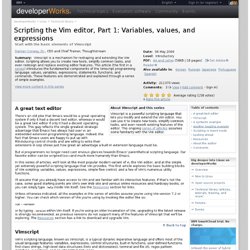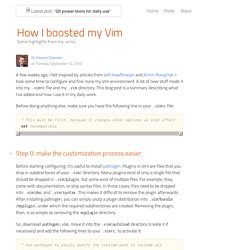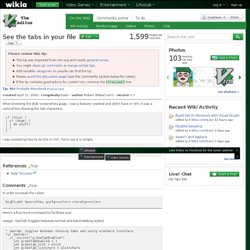

Vim & Vigor Comic - Iceweasel (Build 20131020004007) [work] vim_regs_p1.png (PNG Image, 1111 × 1600 pixels) - Scaled (34%) - Iceweasel (Build 20131020004007) Vim After 11 Years - Ian Langworth's Things of Variable Interest - Iceweasel. Vim cheatsheet - Iceweasel. I'll eventually publish a more comprehensive listing, but for now I just want to make some notes of commands that I discover and don't want to forget.

Commands available in all modes Rotate windows (downwards/rightwards): CTRL-W r or CTRL-W CTRL-R (I had actually searched for this one in the help and online but didn't really know how to describe what I was looking for; turns out the material I was looking for is covered in :h window-moving)Moving a window to occupy to an entire edge of the viewport: CTRL-W followed by H, J, K, L (i.e.. capitalized movement keys); eg. CTRL-W J pushes the current window to the bottom, occupying the full width Insert mode commands Normal mode commands Movement For lots of documentation see :h motion.txt. VIM Tips Blog - Iceweasel. Tags - Iceweasel. Tomtom/quickfixsigns_vim · GitHub - Iceweasel. DeveloperWorks : Linux : Technical library - Iceweasel. Scripting the Vim editor, Part 1: Variables, values, and expressions - Iceweasel. A great text editor There's an old joke that Emacs would be a great operating system if only it had a decent text editor, whereas vi would be a great text editor if only it had a decent operating system.

This gag reflects the single greatest strategic advantage that Emacs has always had over vi: an embedded extension programming language. Indeed, the fact that Emacs users are happy to put up with RSI-inducing control chords and are willing to write their extensions in Lisp shows just how great an advantage a built-in extension language must be.
But vi programmers no longer need cast envious glances towards Emacs' parenthetical scripting language. Our favorite editor can be scripted too—and much more humanely than Emacs. In this series of articles, we'll look at the most popular modern variant of vi, the Vim editor, and at the simple yet extremely powerful scripting language that Vim provides. I'll assume that you already have access to Vim and are familiar with its interactive features. Scripting the Vim editor, Part 2: User-defined functions - Iceweasel. User-defined functions Ask Haskell or Scheme programmers, and they'll tell you that functions are the most important feature of any serious programming language.

Ask C or Perl programmers, and they'll tell you exactly the same thing. Functions provide two essential benefits to the serious programmer: They enable complex computational tasks to be subdivided into pieces small enough to fit comfortably into a single human brain. They allow those subdivided pieces to be given logical and comprehensible names, so they can be competently manipulated by a single human brain. Vimscript is a serious programming language, so it naturally supports the creation of user-defined functions.
Declaring functions Functions in Vimscript are defined using the function keyword, followed by the name of the function, then the list of parameters (which is mandatory, even if the function takes no arguments). Listing 1. The return value of the function is specified with a return statement. Listing 2. Listing 3. How I boosted my Vim » nvie.com - Iceweasel. A few weeks ago, I felt inspired by articles from Jeff Kreeftmeijer and Armin Ronacher.

I took some time to configure and fine-tune my Vim environment. A lot of new stuff made it into my .vimrc file and my .vim directory. This blog post is a summary describing what I’ve added and how I use it in my daily work. Before doing anything else, make sure you have the following line in your .vimrc file: " This must be first, because it changes other options as side effectset nocompatible Step 0: make the customization process easier ¶ Before starting configuring, it’s useful to install pathogen. So, download pathogen.vim, move it into the .vim/autoload directory (create it if necessary) and add the following lines to your .vimrc, to activate it: " Use pathogen to easily modify the runtime path to include all" plugins under the ~/.vim/bundle directorycall pathogen#helptags()call pathogen#runtime_append_all_bundles() " change the mapleader from \ to ,let mapleader=","
See the tabs in your file - Vim Tips Wiki - Iceweasel. When browsing the jEdit screenshots page, I saw a feature I wanted and didn't have in Vim.

It was a vertical line showing the Tab characters. if (this) { | if (that) { | | do stuff; | } } I was wondering how to do this in Vim. Turns out it is simple. TupperVim - Mozilla Francophone - Iceweasel. TupperVim (tupperVim) sur Twitter - Iceweasel... The perfect programming font - Vim Tips Wiki - Iceweasel. Here are some recommendations for fonts to use in gvim, particularly for writing programs. Should probably have separate tips for Linux and Windows font recommendations, or at least make it clearer what works where. Every font should have a screenshot and note if it is free or commercial. Proggy Edit Proggy Clean font from Using gvim with gtk2, I had a problem installing Proggy Clean. Anyway, the ttf font works fine. Then start gvim and and choose the font, or insert this in your .gvimrc: set guifont=ProggyCleanTT\ 12 The 12pt size is necessary for a good look. If you use ProggyCleanTT in gvim and the top of the font looks like garbage, with missing pieces, it is because you have the new freetype hinting turned on.
Neep I prefer the Neep programming font created by Jim Knoble. It differentiates between a zero and the letter "O" and looks really nice.